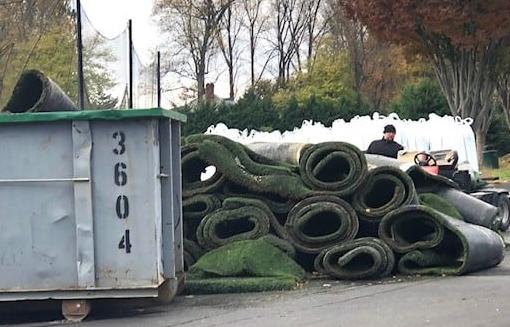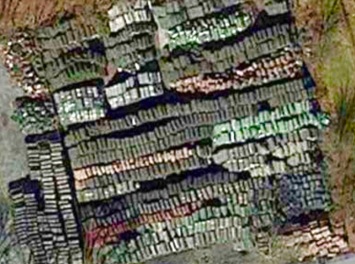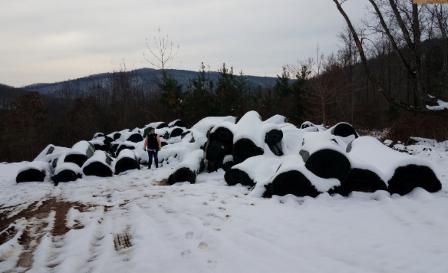
Synthetic turf fields have an 8-10 year average lifetime and produce a large volume of waste, much of it toxic. An average field of 80,000 square feet is comprised of 40,000 pounds of mixed plastic turf and 400,000 pounds of infill – usually tire waste and silica sand. The infill alone for one field amounts to 400 cubic yards, the equivalent of almost fourteen 30-cubic yard dumpsters. The fate of this enormous amount of plastic waste and infill is difficult, if not impossible to track.
There is no official inventory of the number or location of synthetic turf playing fields in Maryland. Since 2021, Maryland Sierra Club volunteers have located 437 synthetic turf fields in 19 of Maryland’s counties and in Baltimore City. For the 403 fields with a reported size, the waste produced over the next decade as they are replaced would amount to:
- More than 79,000 tons of plastic carpet and infill;
- More than 144,000 cubic yards of infill, the equivalent of 4,810 30-yard dumpsters; and
- 28.9 million square feet of plastic carpet (663 acres)
No one knows where the waste from previously replaced synthetic turf fields has been sent, whether it was repurposed or reused, components were recycled, and where the waste was disposed. There is only one certified facility in the world that can recycle all synthetic turf components on an industrial scale -- in Denmark. The industry admits that incineration is not an option for most components. Landfilling is an option, but many waste facilities don’t accept synthetic turf field waste because of its high volume, weight, and toxicity. In some instances, used synthetic turf has been stockpiled in rural areas or illegally been dumped in the environment (see below). When improperly disposed of and uncontained, especially near waterways, these materials pose risks to humans, wildlife, and the environment.
The “Synthetic Turf and Turf Infill – Chain of Custody” bill would
- Require the Maryland Department of the Environment (MDE) to establish a system to track the chain of custody for synthetic turf fields and turf infill in Maryland, from installation to use, repurposing, recycling, and disposal.
- Require the current and future custodians (owners, transporters) of fields to report to MDE certain information on the custodian, contractor, characteristics and location of the synthetic turf and turf infill whenever it changes custody.
- Require the MDE to post information on the chain of custody to a public website.
A publicly disclosed chain of custody will serve as a deterrent for improper disposal and illegal dumping of used synthetic turf fields and infill (see below) as an incentive for proper disposal. The Synthetic Turf Council’s guidelines[1] recommend a chain of custody for turf and infill, but accountability for proper disposal requires that it be reported and that the information be publicly disclosed.

Cleona, PA (photo at right): About 6,000 rolled pieces of turf were stacked about 10 feet high on more than an acre of private land, according to Mayor Larry Minnich. The rolls had been sitting in Cleona for two years, and he decided that was long enough. He was getting complaints from people in town, and there were safety concerns about the pile’s flammability and proximity to a fueling station. “This is what it looks like when someone gets rid of a dozen turf fields and there’s nowhere to send them,” he said.[2]

Albemarle County, VA (photo at left): When the University of Virginia decided to replace two synthetic turf fields, no one accounted for where the synthetic turf waste was going. The contractor drove truckloads into rural Albemarle County and the rolls were dumped on a hillside just up from a stream. A neighbor noticed and alerted authorities. After regulators stepped in, the landowner moved the rolls to a more private site, where it was partially buried. When it was found a few months later it was finally taken to a landfill (199 tons worth).[3]
- Sierra Club Inventory of Maryland's Synthetic Turf Fields: Learn about the number of fields and the waste they will generate statewide and in your jurisdiction, when they are replaced over the next decade. The inventory will be periodically updated.
- Methodology and results
- Summary table of Maryland's synthetic turf fields, ownership, and projected waste, by County, as of January 1, 2024.
- List of Maryland synthetic turf fields by county, as of January 1, 2024.
- Please help us by reporting: 1) a new field, 2) information or correction on a listed field, or 3) a replaced field.
- Support the 2024 Synthetic Turf Chain of Custody Bill (HB 457)! The Synthetic Turf Chain of Custody bill passed the House of Delegates twice, in 2022 and 2023, but was stalled in the Senate. Contact your legislators to get this bill over the finish line in 2024!
[1] Synthetic Turf Council. 2017. A Guideline to Recycle, Reuse, Repurpose, and Remove Synthetic Turf Systems.
[2] Candy Woodall. 2019. “Old turf fields raise environmental, health concerns across country,” Rome Sentinel, Rome, NY, November 30.
[3] Myers, Pete. 2019. “Hidden gotcha in artificial turf installations,” Environmental Health News, December.